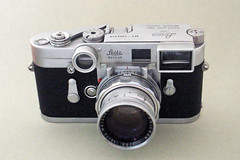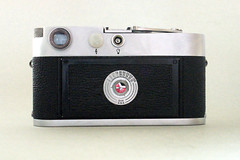Difference between revisions of "Leica M3"
m (correcting Collection Appareils link) |
(Revisions, clean up, & merge M2 article) |
||
| Line 6: | Line 6: | ||
|image_by= rst12 | |image_by= rst12 | ||
|image_credit=with permission | |image_credit=with permission | ||
| − | + | }} | |
| − | |||
| − | |||
| − | |||
| − | |||
| − | |||
| − | |||
| − | |||
The '''[[Leica]] M3''' was introduced in 1954. It was a new starting point for [[Leitz]], which until then had only produced [[Leica screw mount|screw-mount Leica cameras]] that were incremental improvements to its original Leica (''[[Ur-Leica]]''). Leica M cameras are still in production today. The M3 introduced several features to the Leica, among them the combination of [[viewfinder]] and [[rangefinder (device)|rangefinder]] in one bright window, and a bayonet lens mount. | The '''[[Leica]] M3''' was introduced in 1954. It was a new starting point for [[Leitz]], which until then had only produced [[Leica screw mount|screw-mount Leica cameras]] that were incremental improvements to its original Leica (''[[Ur-Leica]]''). Leica M cameras are still in production today. The M3 introduced several features to the Leica, among them the combination of [[viewfinder]] and [[rangefinder (device)|rangefinder]] in one bright window, and a bayonet lens mount. | ||
| − | == | + | ==Lens mount== |
| − | This new bayonet mount, which has not been changed in the following half century, is called the [[Leica M mount]]. Lenses | + | This new bayonet mount, which has not been changed in the following half century, is called the [[Leica M mount]]. Lenses can be changed faster than with a screw mount, and framelines set automatically. Non-Leitz/Leica bayonet-mount lenses can also be used (although none were produced in any quantity while the M3 was sold), and a simple adapter also allows the use of screwmount lenses (whether from Leitz or other companies). |
{|class=plainlinks | {|class=plainlinks | ||
| Line 29: | Line 22: | ||
|} | |} | ||
| − | == | + | == Viewfinder == |
{{Flickr_image | {{Flickr_image | ||
|image_source= http://www.flickr.com/photos/solid_max/4494638388/in/pool-camerawiki | |image_source= http://www.flickr.com/photos/solid_max/4494638388/in/pool-camerawiki | ||
| Line 38: | Line 31: | ||
|image_rights= wp | |image_rights= wp | ||
}} | }} | ||
| − | + | Compared to the preceding [[Leica IIIf|IIIf]], the M3 has an exceptionally bright viewfinder. It also has a high magnification factor, which is very useful in critical focusing. The M3 has a factor of 0.92×, while other Leicas use 0.85×, 0.72×, or less. Furthermore, it was the first Leica to combine [[rangefinder (device)|rangefinder]] and viewfinder into one window. (Other cameras, such as the [[Contax II]], already had this feature before the war; and other companies were making screwmount bodies with combined finders.) Framelines for 50, 90 and 135mm are shown, although none for any wider lenses. However, Leica solved this problem in two different ways. One was using a separate viewfinder slid into the accessory shoe. The other way is the use of so called ''Leica glasses''; auxiliary lenses are put in front of the viewfinder and rangefinder windows for the 35mm focal length. The drawback of these glasses is they reduce the famed brightness of the finder. | |
| − | The 50 mm framelines are always visible | + | The 50 mm framelines are always visible in the slightly larger viewfinder image. There are two ways to select the 90mm or 135mm framelines. Mounting a 90mm lens will automatically select the corresponding framelines. The other way is toggling a small lever on the left of the lens. This way, the tele-framelines for other lenses can be seen when using a 50mm lens, which shows the field of view for another focal length. |
| − | [[Viewfinder camera]]s don't show the | + | [[Viewfinder camera]]s don't show exactly the same image in the viewfinder and on film. This ''[[parallax]]'' problem is compensated in the M3 by moving the framelines when focussing the lens. This parallax compensation has its limits, but in most practical situations, works well. |
| − | == | + | ==Film transport== |
| − | Leica IIIF and its predecessors had used a knob to advance the film. For fear of tearing the film, early M3s had a double stroke advance lever, just as the [[Neoca 2S]] had. Later models had single-stroke levers, which speeded up operation of the camera. Another | + | Leica IIIF and its predecessors had used a knob to advance the film. For fear of tearing the film, early M3s had a double stroke advance lever, just as the [[Neoca 2S]] had. Later models had single-stroke levers, which speeded up operation of the camera. Another variation is in the film pressure plate. Early models used a glass plate to keep the film flat, later models used a metal plate. |
| − | == | + | == Shutter == |
| − | Earlier Leicas had used two | + | Earlier Leicas had used two rings with separate slow and fast speeds which rotated on exposure, as on the [[Exakta Varex]]. The M3 combined all speeds on a single fixed dial, partly to reduce vibrations in the camera. Early models used a non-geometrical series of shutter speeds. On later models this became the international standard of 1s to 1/1000s. |
| − | == | + | {{Flickr image |
| − | + | | image_source=http://www.flickr.com/photos/diong/3390553520/in/pool-camerawiki | |
| − | Leica's model numbering scheme has often caused confusion among users and collectors alike. The next model introduced by Leica was the | + | | image=http://farm4.static.flickr.com/3630/3390553520_90f19a83f9.jpg |
| + | | image_align=right | ||
| + | | image_text=The '''M2''' was the "budget" [[Leica M3]] variant of 1958 | ||
| + | |image_by=Dennis Leonardo | ||
| + | |image_rights=wp | ||
| + | }} | ||
| + | == M2 and M1== | ||
| + | Leica's model numbering scheme has often caused confusion among users and collectors alike. The next model introduced by Leica was the M2. This was a cost-reduced M3 with a different selection of viewfinder framelines (35, 50, and 90mm) and other changes suggested by professional photojournalists, who were Leica's primary customers at the time. The M2 was sold alongside the M3, and both continued production with minor changes until eventually replaced by the [[Leica M4|M4]]. The M1 was also based on the M3 body. It had no rangefinder and was primarily intended to be mounted on a microscope or telescope for use as a scientific instrument camera. | ||
All Leica M series cameras, even the radically redesigned [[Leica M5|M5]], can be recognised by their basic resemblance to the M3 that started the series. Many consider the M3 to be the most beautiful Leica ever made.<!-- What, if anything, does this mean? --><!-- see discussion for a reply--> At the same time, the lack of wide-angle frame lines is sometimes regretted. | All Leica M series cameras, even the radically redesigned [[Leica M5|M5]], can be recognised by their basic resemblance to the M3 that started the series. Many consider the M3 to be the most beautiful Leica ever made.<!-- What, if anything, does this mean? --><!-- see discussion for a reply--> At the same time, the lack of wide-angle frame lines is sometimes regretted. | ||
Revision as of 10:51, 11 January 2013
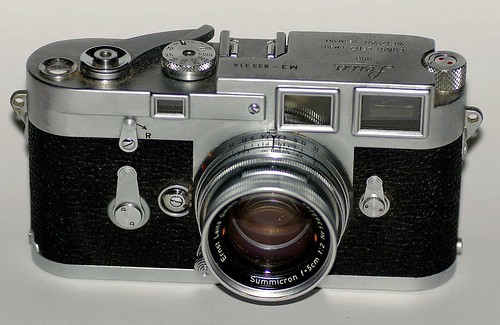
|
| Leica M3 with collapsible summicron 5cm image by rst12 |
The Leica M3 was introduced in 1954. It was a new starting point for Leitz, which until then had only produced screw-mount Leica cameras that were incremental improvements to its original Leica (Ur-Leica). Leica M cameras are still in production today. The M3 introduced several features to the Leica, among them the combination of viewfinder and rangefinder in one bright window, and a bayonet lens mount.
Lens mount
This new bayonet mount, which has not been changed in the following half century, is called the Leica M mount. Lenses can be changed faster than with a screw mount, and framelines set automatically. Non-Leitz/Leica bayonet-mount lenses can also be used (although none were produced in any quantity while the M3 was sold), and a simple adapter also allows the use of screwmount lenses (whether from Leitz or other companies).
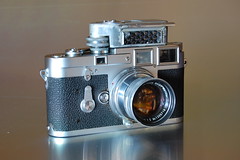
|
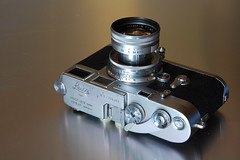
|
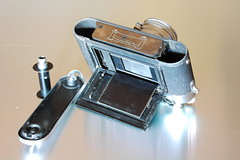
|
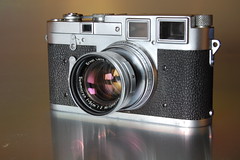
|
| images by Raúl Sá Dantas (Image rights) | |||
Viewfinder
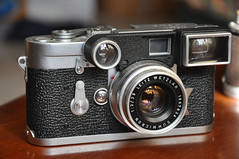
|
| Leica M3 image by M*LoW - Massimo (Image rights) |
Compared to the preceding IIIf, the M3 has an exceptionally bright viewfinder. It also has a high magnification factor, which is very useful in critical focusing. The M3 has a factor of 0.92×, while other Leicas use 0.85×, 0.72×, or less. Furthermore, it was the first Leica to combine rangefinder and viewfinder into one window. (Other cameras, such as the Contax II, already had this feature before the war; and other companies were making screwmount bodies with combined finders.) Framelines for 50, 90 and 135mm are shown, although none for any wider lenses. However, Leica solved this problem in two different ways. One was using a separate viewfinder slid into the accessory shoe. The other way is the use of so called Leica glasses; auxiliary lenses are put in front of the viewfinder and rangefinder windows for the 35mm focal length. The drawback of these glasses is they reduce the famed brightness of the finder.
The 50 mm framelines are always visible in the slightly larger viewfinder image. There are two ways to select the 90mm or 135mm framelines. Mounting a 90mm lens will automatically select the corresponding framelines. The other way is toggling a small lever on the left of the lens. This way, the tele-framelines for other lenses can be seen when using a 50mm lens, which shows the field of view for another focal length.
Viewfinder cameras don't show exactly the same image in the viewfinder and on film. This parallax problem is compensated in the M3 by moving the framelines when focussing the lens. This parallax compensation has its limits, but in most practical situations, works well.
Film transport
Leica IIIF and its predecessors had used a knob to advance the film. For fear of tearing the film, early M3s had a double stroke advance lever, just as the Neoca 2S had. Later models had single-stroke levers, which speeded up operation of the camera. Another variation is in the film pressure plate. Early models used a glass plate to keep the film flat, later models used a metal plate.
Shutter
Earlier Leicas had used two rings with separate slow and fast speeds which rotated on exposure, as on the Exakta Varex. The M3 combined all speeds on a single fixed dial, partly to reduce vibrations in the camera. Early models used a non-geometrical series of shutter speeds. On later models this became the international standard of 1s to 1/1000s.

|
| The M2 was the "budget" Leica M3 variant of 1958 image by Dennis Leonardo (Image rights) |
M2 and M1
Leica's model numbering scheme has often caused confusion among users and collectors alike. The next model introduced by Leica was the M2. This was a cost-reduced M3 with a different selection of viewfinder framelines (35, 50, and 90mm) and other changes suggested by professional photojournalists, who were Leica's primary customers at the time. The M2 was sold alongside the M3, and both continued production with minor changes until eventually replaced by the M4. The M1 was also based on the M3 body. It had no rangefinder and was primarily intended to be mounted on a microscope or telescope for use as a scientific instrument camera.
All Leica M series cameras, even the radically redesigned M5, can be recognised by their basic resemblance to the M3 that started the series. Many consider the M3 to be the most beautiful Leica ever made. At the same time, the lack of wide-angle frame lines is sometimes regretted.
Links
In English:
- The Leica M Camera Price Guide
- The Leica M3 within Stephen Gandy's Leica M guide
- Leica M3 listed at number 10 in Jason Schneider's Top 20 Cameras Of All-Time on Shutterbug.
- Servicing M series Leicas, at Pentax Manuals
In Spanish:
In French:
- Leica M3 at summilux.net
- Leica M3 1955, Leica M3 1957 on www.collection-appareils.fr by Sylvain Halgand
images by Dries van den Elzen (Image rights)



